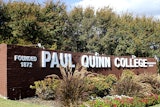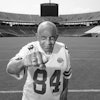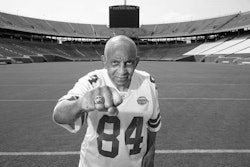The future of African American football coaches may fall victim to the assault on affirmative action
In this year’s pursuit of head coaching positions at NCAA Division
I-A institutions, college sports’ top competitive classification, Black
coaches once again have found themselves shut out — an outcome that
leaves many pondering just what to do to correct the situation.
And to make matters worse, the dismissal of three Black head
football coaches — Ron Dickerson at Temple University, Ron Cooper at
the University of Louisville, and Matt Simon at the University of North
Texas — reduced the number of African American head coaches among the
112 Division I-A football institutions to five. This in a sport where
46 percent of the student athletes are Black.
In fact, a total of only fourteen African Americans have ever held
the position of head football coach at Division I-A institutions.
“This is deplorable,” says Rudy Washington, executive director of
the Black Coaches Association (BCA) — which has been working for a
decade to improve the numbers of Black coaches, particularly in head
coaching positions. “It is getting to be a situation where Black
football coaches are used to recruit college athletes but are not used
to run the teams — and that is disturbing. We are going to sit down
and have a meeting shortly to try to develop a strategy.”
Alex Wood, vice president of the, BCA and the head football coach
at James Madison University (JMU), was equally dismayed at the lack of
hiring of Black head coaches in the division, noting that over a
two-year span there have been thirty-five such openings and only one
Black hire. There were nine openings this year.
“My immediate reaction this year is the same as last year when
there were twenty-six openings and one hiring,” Wood says. “There are
obviously no concerns about hiring Black head coaches in I-A.
“I think it is because there is no external policing [forcing
institutions] to do the right thing anymore,” he explains. “Affirmative
action is no longer enforceable, and it is a thing of the past. No one
is feeling a sense of urgency for giving opportunities. They’re saying,
`Let’s stay in the comfort zone with our hiring practices.'”
According to Wood, the situation becomes more appalling in light of
the extensive lobbying the BCA has conducted with those who do the
actual hiring — college presidents and athletic directors.
“We did as much as anybody to bring this to light by way of the
media, with seminars, and invitations to our convention to try to break
the ice,” says Wood. “But the ice is much thicker than we thought.”
While lamenting the loss of Dickerson, Cooper, and Simon, Wood
promised that the BCA would address the situation. He would not,
however, reveal any potential plans the association is considering.
“Any movement is dramatic,” observes Wood. “We could all get wiped
out in a year, but that is the nature of [who] we are as minorities. We
are minorities in a society and minorities in a profession. But we are
not going to make a knee-jerk reaction. When one gets a job, they have
to produce. Nothing is guaranteed. College coaching — coaching, in
general — is a volatile profession.”
Missing Invitations
Also working on ways to increase the number of Black head football
coaches is the NCAA Minority Opportunities and Interests Committee,
chaired by Charles Whitcomb of San Jose State University (SJSU).
“Obviously, we are not making the kind of progress we should be
making,” the faculty athletics representative at SJSU says. “There are
qualified Black coaches out there [who] should be considered for
various positions.
“There will be continued effort out of our committee; we’re not
giving up. We’re going to have to try to address this at different
levels because what we are doing so far has not made a significant
impact or difference,” continues Whitcomb. “We have to confront
athletic directors and conferences as groups and develop strategies to
help the entire arena be more aggressive and sensitive in how they do
hiring at the conference level and on individual campuses.”
But Whitcomb and others concede that schools cannot be forced to hire anyone.
“Yes, we realize that,” says Whitcomb. “But Blacks are not even
getting interviews. Schools must be encouraged to give access to
opportunity [so that African Americans] at least have a chance of
competing on a level field…. Right now, they are not even invited to
compete.”
Grant Teaff, executive director of the American Football Coaches
Association (AFCA), also points a finger at the institutions’
administration.
“You have to be interviewed before you can ever-be hired,” he says.
“Next thing that we’ve got to see is that more minority coaches get a
chance to be interviewed. It is like everything else — you’ve got to
go in and impress. But you can’t impress if you don’t get the
interview.”
And Whitcomb has another worry.
“How do you finally get people’s attention that this [problem] is
real? This is not something that comes and goes and is not coming back
again,” he says. “Student athletes who are Black seem to increase, but
those [minorities] who provide leadership and direction continue to
decrease.”
The situation is a major concern at NCAA headquarters, according to
Dan Boggan, the association’s chief operating officer and highest
ranking African American official.
“This is an issue we have got to come to grips with,” says Boggan,
after noting that Cedric Dempsey, the NCAA’s executive director,
directly commented on the situation during his state of the association
address in January.
In that address, Dempsey called on University presidents and
athletics directors to consider the hiring record of the last two years
and become more aggressive and fair-minded towards minorities when
considering applicants for head coaching jobs.
“I want to make sure the NCAA leads by example with regards to
issues of inclusion and diversity,” Dempsey said in his address.
“Everyone benefits from diversity of thought, experience, and
leadership. This is especially true for young student athletes as it
relates to diversity within our coaching ranks. In your last
recruitment for a coach, what steps did you take to increase the ethnic
and gender diversity of your staff? Our performance in this area leaves
much to be desired. We must all redouble our efforts.”
Although AFCA’s Teaff agrees that the hiring record is skewed, he
believes that the climate is changing for the better. According to him,
it is inevitable that more Black head coaches will be hired. The
problem this year, he says, was the small number of openings compared
with last year.
“That still doesn’t excuse that we didn’t have any [Black] gains in
head coaching hiring,” Teaff admits. “But I am optimistic about it
because we have added a significant number of Black coaches to the
offensive and defensive coordinator positions and that is always a
stepping-stone to head coach. With more coordinators, there are going
to be more opportunities to land a head coaching job.”
Teaff says AFCA is “making a concerted effort” to help develop
minority coaches. Additionally, the organization is pushing the concept
that AFCA is an association for all coaches — minority as well as
non-minority.
“Four years ago, we created a minority issues committee that
reports to our board,” explains Teaff, “and it has been in the last
four years that you see a rise in the number of Black coordinators. We
are going to continue our efforts.”
According to the 1997 Racial Report Card (see story, page 23), of
the 3,208 assistant football coaches in all levels of NCAA competition
— excluding those at HBCUs — 481 (15 percent) are Black. When
considering only Division I — excluding those at HBCUs — the
percentage increases to 18 percent.
The HBCU Connection
The loss of the three Black coaches in Division I-A schools has
proven to be fortuitous for historically Black colleges and
universities. Alabama State University hired Dickerson shortly after he
was axed at Temple, and Alabama A&M University picked up Cooper
after he was able to negotiate a $1 million settlement with Louisville.
Simon, who was abruptly relieved of his duties after battling the
athletics department at North Texas over issues such as financial
support and scheduling, is still looking for work.
Some thought it profound that two of the Blacks who fell from
Division I-A grace have surfaced at HBCUs. However, W. Curtis Williams,
Alabama State’s athletics director, sees no such profundity.
“We were not looking directly to try to hire a coach — Black or
White — from a predominantly White institution,” says Williams, who
adds they did consider some White applicants. “We were trying to
identify the best person for the job, the one who had the personality
and experience related to our particular situation and our particular
issues.
“Ron [Dickerson] fit that bill and we feel, with his level of
celebrity and his past experiences, he will be able to come in and
solidify our constituency,” he explains. “He’ll be able to relate to
the community, relate to the alumni and students, and be able to
recruit within our community.”
Williams said he couldn’t speak directly to what traditionally
White institutions (TWIs) look for when they seek a head football
coach, but he felt there always have been concerns about how a coach
will relate to the “country club set, how he will deal with the bank
president.”
“This is problematic of all coaches, Black or White,” Williams
says, “but it is easier if you are White. When you are Black or
represent a Black institution, corporate America changes the level of
identity [on which] they deal with you. They don’t receive me or deal
with me on the same level that they deal with Auburn or Alabama.”
Williams agrees that the time is ripe for an increase in Black head
coaches, pointing to the proliferation of Black offensive and defensive
coordinators. And he also places the onus for the poor numbers on the
shoulders of the administrations at TWIs.
“Sometimes [TWIs] wait for people to apply,” he says. “Instead,
they have to identify candidates and say, ‘Bring this person to me.’
Sometimes they don’t go far enough in identifying the top people.”
But Williams added that it is also incumbent upon the Black
athletics community “to identify those coaches who are significant
talent and talk to them about bridging the gap, being one of the first,
and opening doors for someone else.”
Rattling off the names of several prominent Black coaches, Williams
says, “We have to tell them, ‘You have talent, you have to aspire to
the next level. You can be the coach of Notre Dame.’ We have to put our
best up for consideration. We have to want to put these people up for
top leadership roles and inspire other coaches [to see] that they have
a chance at the next level…. We have to put — coaches there so they
can do what we know they can do and blaze a trail for others.”
And although Black coaches from HBCUs need to be included in the equation, they unfortunately are overlooked, says Williams.
“[TWs] are identifying the top Black coaches at other White
institutions and bring them into coordinator positions, the next step
to the head coach position,” he says. “But they are not coming from
Black programs where they are serving as head coaches.”
Widening the Inroads
“The inroad to a head job [for Black coaches from HBCUs] is to
leave Black institutions and go serve as an assistant at a White
school,” continues Williams. “Then you are in line for a [head
coaching] job, and that is what is not fair. It is difficult to get
selected from a Black school.”
“It is important that talent in those historically Black colleges
have the opportunity to be Division I-A coaches,” says the NCAA’s
Boggan. “They should be a place where people look and the ability to go
back and forth should be natural. There should be no stigma attached to
it. I am glad to see Dickerson and Cooper go to historically Black
schools, but it has got to go both ways.”
BCA’s Washington was “pleasantly surprised” to see Cooper and
Dickerson end up where re they did. However, he always felt HBCUs were
hotbeds of coaching talent, although “they haven’t been accepted like
that. We have to fight against that.”
Whitcomb, of the NCAA, says that TWIs searching for Black head
coaches are not sensitive to HBCUs, “where there are people already
serving as head coaches and in coordinator positions.” He rejects the
notion that HBCUs have inferior athletics programs.
JMU’s Wood offers a novel approach to the problem. Over the next
ten years, he suggests that a few Black institutions — based on
geography, size, and commitment — be phased into Division I-A
conferences with the blessing and help of the NCAA.
The highest level of collegiate athletic competition an HBCU can
currently aspire to is Division I-AA. Aside from being less-populated
campuses — usually — Division I-AA institutions are allowed to offer
only sixty-three football scholarships, as opposed to the eighty-five
offered at I-A schools; have much less access to television exposure
and the rewards garnered from that exposure; and are not permitted to
participate in the large revenue-producing bowl games at the end of the
season.
The new Division I-A schools could then participate in Division IA
revenue sharing and television exposure, as well as compete for
postseason bowl games. They would also be able to add twenty-two
additional scholarships, providing additional educational opportunities
and allowing them to be more competitive.
The additional money, exposure, and higher level of competition
would help make Black schools more appealing to Black athletes,
providing recruitment equity, according to Wood.
And with the likelihood that the new Division I-A schools would
have Black head coaches and Black athletics administrators, those
institutions would provide an additional and equitable training ground
that White institutions would find more acceptable.
“Right now, the system is separate, but not equal,” says Wood.
“This plan would help to bring some kind of equity and get rid of the
Jim Crow system which right now is alive and well.”
“Good coaches should have the right, Black or White, to pursue jobs
on the open market,” says Williams. “If you get selected, it should be
because you bring something to the table that other candidates don’t
have.”
BI THE NUMBERS
Division I Male Student Athletes (in percentages)
Basketball Football Baseball
White 37.4 47.2 89.4
Black 61.0 52.0 6.5
Latino 1.6 1.8 4.1
COPYRIGHT 1998 Cox, Matthews & Associates
© Copyright 2005 by DiverseEducation.com















